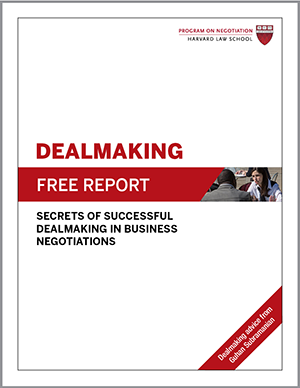Adapted from “Pull Ahead of the Pack with a Negotiauction,” from the January 2010 issue of the Negotiation newsletter.
Robert Barnett, a corporate attorney based in Washington, D.C., moonlights as a book agent for celebrity politicians—including Barack Obama, Laura Bush, and Bill and Hillary Clinton. New York editors line up to sign Barnett’s clients and, they hope, rake in blockbuster profits.
Barnett’s technique is to introduce his latest superstar to the major publishing houses and then hold a multiround auction, writes Guhan Subramanian, a Program on Negotiation faculty member, instructor in our executive education courses, and Negotiation Briefing’s academic editor, in his new book, Negotiauctions: New Dealmaking Strategies for a Competitive Marketplace (Norton, 2010). After the first round of bidding, Barnett gives low bidders chance to top the high bid, until an unbeatable offer emerges.
Back in 1993, Barnett’s auction format took a new turn when he was shopping James Carville and Mary Matalin’s joint memoir of the 1992 presidential campaign. As you’ll recall, the two improbably fell in love while fighting each other as lead political operatives for Bill Clinton (Carville) and George H. W. Bush (Matalin).
After a few rounds of bidding, the auction reached a fever pitch.
Then things got interesting. At a party, Richard Snyder, the chairman of Simon & Schuster, bumped into Harold Evans, the head of Random House’s adult trade division. Both were competing in the Carville-Matalin auction.
Snyder suggested a novel strategy: Why not team up and submit a joint bid?
Soon the announcement came that rivals Simon & Schuster and Random House would be publishing Carville and Matalin’s memoir for an impressive (but undisclosed) sum. The two firms would make decisions on the book together and split its profits and losses equally.
“It’s like the Hatfields and the McCoys publishing the Montagues and the Capulets,” a delighted Barnett told the New York Times. Carville and Matalin’s book, All’s Fair: Love, War, and Running for President, was a bestseller, thanks in part to the free publicity surrounding the unorthodox business arrangement.
Was the deal a negotiation or an auction?
Clearly, it was both.
A number of parties bid in an auction; two of them negotiated with each other and then jointly with Barnett.
The deal was what Subramanian terms a negotiauction—a transaction in which both auction-style bidding and one-on-one negotiation occur in the course of a single deal.
In fact, many (if not most) complex deals between buyers and sellers—from home sales to purchasing auctions to corporate mergers—qualify as negotiauctions. Yet because negotiation and auction advice tend to come from two different camps, real-world dealmakers have had to navigate this rocky terrain intuitively. Here we review Subramanian’s guidance on thriving in this challenging yet potentially rewarding environment.
What’s a “negotiauction”?
A negotiauction has the following features, according to Subramanian:
1. One-on-one negotiations.
At some stage during a negotiauction, the seller engages one or more buyers in private discussions about the asset on the table.
2. One or more rounds of bidding.
At a certain point during a negotiauction, the seller pits potential buyers against one another in an auction.
3. Several, but not too many, potential buyers.
Typically, between three and 10 potential buyers are needed for a negotiauction—enough parties to spark an auction but not so many that one-on-one negotiation would be difficult for the seller to manage.
4. Information disparity.
In a negotiauction, the seller usually knows more about the situation and the asset at stake than potential buyers do. Buyers face the challenge of overcoming this information asymmetry.
5. Process ambiguity.
In a traditional auction, the seller determines the process (whether there will be a single round of bidding or multiple rounds, for instance), and buyers are passive participants. In a negotiauction, by contrast, the process is up for grabs. Canny buyers seize opportunities to change the process to their advantage, as the two publishers did in our opening example.
A negotiauction often begins as an auction that narrows the field, followed by one-on-one negotiations with the highest bidders.
But that’s not always the case. Someone shopping for a new car could hold an Internet auction and then try to negotiate better terms with the lowest bidder. Alternatively, she could first meet with dealers individually to discuss options and only later encourage them to engage in auction style competition for her business.
As this example illustrates, perhaps the key trait of negotiauctions is flexibility.





